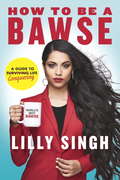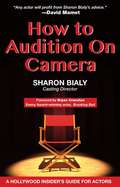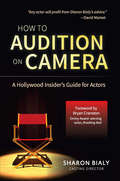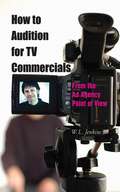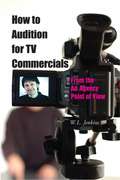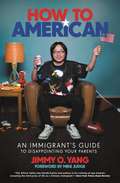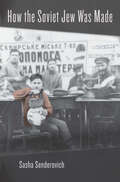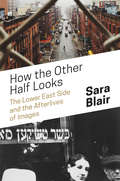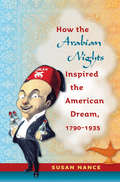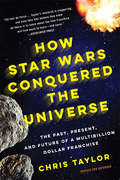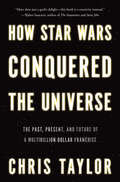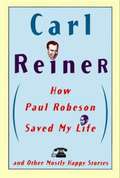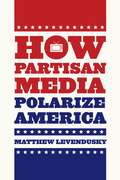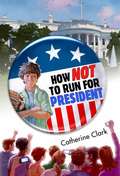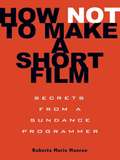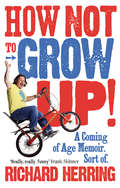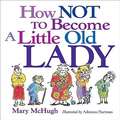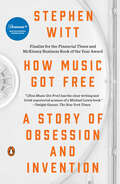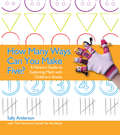- Table View
- List View
How to Be a Bawse: A Guide to Conquering Life
by Lilly SinghFrom the 2017 People's Choice Award winner for Favorite YouTube Star comes the definitive guide to being a bawse: a person who exudes confidence, hustles relentlessly and smiles genuinely because he or she has fought through it all and made it out the other side.Lilly Singh isn't just a superstar. She's Superwoman—which is also the name of her wildly popular YouTube channel. Funny, smart and insightful, the actress and comedian covers topics ranging from relationships to career choices to everyday annoyances. It's no wonder she's garnered more than a billion views. But Lilly didn't get to the top by being lucky—she had to work for it. Hard.Now Lilly wants to share the lessons she learned while taking the world by storm, and the tools she used to do it. How to Be a Bawse is the definitive guide to conquering life. Make no mistake, there are no shortcuts to success, personal or professional. World domination requires real effort, dedication and determination. Just consider Lilly a personal trainer for your life—with fifty rules to get you in the game, including:• Let Go of FOMO (Fear of Missing Out): Temptation will try to steer you away from your goals. FOMO is just a test of your priorities, a test that a bawse is ready to pass.• Be Nice to People: Treat niceness like an item on your daily to-do list. People will go out of their way to help and support you because you make them feel good.• Schedule Inspiration: Lack of motivation isn't permanent or a sign of weakness. Expect it and proactively schedule time to be creative. • Be the Dumbest: Challenge yourself by surrounding yourself with people who know more than you do. It's a vital way to learn and improve. Told in Lilly's hilarious, bold voice and packed with photos and candid stories from her journey to the top, How to Be a Bawse will make you love your life and yourself—even more than you love Beyoncé. (Yes, we said it!) WARNING: This book does not include hopeful thoughts, lucky charms or cute quotes. That's because success, happiness and everything else you want in life need to be worked for, not wished for. In Lilly's world, there are no escalators, only stairs. Get ready to climb.Advance praise for How to Be a Bawse: "Lilly is a bona fide #girlboss, boss and bawse. Her meteoric rise has come with so many incredible lessons that we are all lucky to have access to. This book is a must-have for the hustler in all of us." —Sophia Amoruso, founder and CEO, Girlboss
How To Audition On Camera: A Hollywood Insider's Guide for Actors
by Sharon Bialy Bryan CranstonTo win a role in a movie or on network or cable TV, you must make a strong first impression in your brief, crucial audition--and the first person you have to impress is the casting director. In How to Audition On Camera, Casting Director Sharon Bialy answers the twenty-five questions actors ask most frequently about how to nail an audition. What is the casting director looking for? If you mess up, can you start over? What is the most common mistake experienced actors make? Should you audition off book or can you look at the page? Should you dress in character? How much can you improvise? Actors--both novice and professional--are often misled by myths and outdated prescriptions. This guide replaces such misinformation with concise and accurate advice from someone who is in the room helping to make the decision on who gets the job. Bialy gets readers started immediately on the road to screen acting success.
How To Audition On Camera: A Hollywood Insider's Guide for Actors
by Sharon Bialy Bryan CranstonFirst Time in Print Updated and expanded To win a role in a movie or on network or cable TV, you must make a strong first impression in your brief, crucial audition—and the first person you have to impress is the casting director. In How to Audition On Camera, Casting Director Sharon Bialy answers the twenty-five questions actors ask most frequently about how to nail an audition. What is the casting director looking for? If you mess up, can you start over? What is the most common mistake experienced actors make? Should you audition off book or can you look at the page? Should you dress in character? How much can you improvise? Actors—both novice and professional—are often misled by myths and outdated prescriptions. This guide replaces such misinformation with concise and accurate advice from someone who is in the room helping to make the decision on who gets the job. Bialy gets readers started immediately on the road to screen acting success.
How to Audition for TV Commercials: From the Ad Agency Point of View
by W. L. JenkinsWhat do ad agencies look for when casting TV commercials? This insider's guide, written by a former actor turned ad agency exec, has the answers. It provides step-by-step instructions to help actors understand and master the entire process, from assessing one's looks and personality to the agency preproduction process, from reading scripts and understanding storyboards to preparing for the audition, doing the shoot, and more.Allworth Press, an imprint of Skyhorse Publishing, publishes a broad range of books on the visual and performing arts, with emphasis on the business of art. Our titles cover subjects such as graphic design, theater, branding, fine art, photography, interior design, writing, acting, film, how to start careers, business and legal forms, business practices, and more. While we don't aspire to publish a New York Times bestseller or a national bestseller, we are deeply committed to quality books that help creative professionals succeed and thrive. We often publish in areas overlooked by other publishers and welcome the author whose expertise can help our audience of readers.
How to Audition for TV Commercials
by W. L. JenkinsWhat do ad agencies look for when casting TV commercials? This insider's guide, written by a former actor turned ad agency exec, has the answers. It provides step-by-step instructions to help actors understand and master the entire process, from assessing one's looks and personality to the agency preproduction process, from reading scripts and understanding storyboards to preparing for the audition, doing the shoot, and more.
How to American: An Immigrant's Guide to Disappointing Your Parents
by Jimmy O. Yang Mike JudgeStandup comic, actor and fan favorite from the popular HBO series Silicon Valley shares his memoir of growing up as a Chinese immigrant in California and making it in Hollywood."I turned down a job in finance to pursue a career in stand-up comedy. My dad thought I was crazy. But I figured it was better to disappoint my parents for a few years than to disappoint myself for the rest of my life. I had to disappoint them in order to pursue what I loved. That was the only way to have my Chinese turnip cake and eat an American apple pie too."Jimmy O. Yang is a standup comedian, film and TV actor and fan favorite as the character Jian Yang from the popular HBO series Silicon Valley. In How to American, he shares his story of growing up as a Chinese immigrant who pursued a Hollywood career against the wishes of his parents: Yang arrived in Los Angeles from Hong Kong at age 13, learned English by watching BET RapCity for three hours a day, and worked as a strip club DJ while pursuing his comedy career. He chronicles a near deportation episode during a college trip Tijuana to finally becoming a proud US citizen ten years later. Featuring those and many other hilarious stories, while sharing some hard-earned lessons, How to American mocks stereotypes while offering tongue in cheek advice on pursuing the American dreams of fame, fortune, and strippers.
How the Soviet Jew Was Made
by Sasha SenderovichA close reading of postrevolutionary Russian and Yiddish literature and film recasts the Soviet Jew as a novel cultural figure: not just a minority but an ambivalent character navigating between the Jewish past and Bolshevik modernity.The Russian Revolution of 1917 transformed the Jewish community of the former tsarist empire. In particular, the Bolshevik government eliminated the requirement that most Jews reside in the Pale of Settlement in what had been Russia’s western borderlands. Many Jews quickly exited the shtetls, seeking prospects elsewhere. Some left for bigger cities, others for Europe, America, or Palestine. Thousands tried their luck in the newly established Jewish Autonomous Region in the Far East, where urban merchants would become tillers of the soil. For these Jews, Soviet modernity meant freedom, the possibility of the new, and the pressure to discard old ways of life.This ambivalence was embodied in the Soviet Jew—not just a descriptive demographic term but a novel cultural figure. In insightful readings of Yiddish and Russian literature, films, and reportage, Sasha Senderovich finds characters traversing space and history and carrying with them the dislodged practices and archetypes of a lost Jewish world. There is the Siberian settler of Viktor Fink’s Jews in the Taiga, the folkloric trickster of Isaac Babel, and the fragmented, bickering family of Moyshe Kulbak’s The Zemlenyaners, whose insular lives are disrupted by the march of technological, political, and social change. There is the collector of ethnographic tidbits, the pogrom survivor, the émigré who repatriates to the USSR.Senderovich urges us to see the Soviet Jew anew, as not only a minority but also a particular kind of liminal being. How the Soviet Jew Was Made emerges as a profound meditation on culture and identity in a shifting landscape.
How the People Sang the Mountains Up: How and Why Stories
by Maria LeachThis book tells some of the most famous how and why stories, such as Why Rabbit has a Short Tail?, How the Horse was created?, and Why man has dogs? These stories are collected from around the world and in many different cultures. There is a bibliography and notes on the different stories. Delightful book for all ages.
How the Other Half Looks: The Lower East Side and the Afterlives of Images
by Sara BlairHow New York’s Lower East Side inspired new ways of seeing AmericaNew York City's Lower East Side, long viewed as the space of what Jacob Riis notoriously called the "other half," was also a crucible for experimentation in photography, film, literature, and visual technologies. This book takes an unprecedented look at the practices of observation that emerged from this critical site of encounter, showing how they have informed literary and everyday narratives of America, its citizens, and its possible futures.Taking readers from the mid-nineteenth century to the present, Sara Blair traces the career of the Lower East Side as a place where image-makers, writers, and social reformers tested new techniques for apprehending America--and their subjects looked back, confronting the means used to represent them. This dynamic shaped the birth of American photojournalism, the writings of Stephen Crane and Abraham Cahan, and the forms of early cinema. During the 1930s, the emptying ghetto opened contested views of the modern city, animating the work of such writers and photographers as Henry Roth, Walker Evans, and Ben Shahn. After World War II, the Lower East Side became a key resource for imagining poetic revolution, as in the work of Allen Ginsberg and LeRoi Jones, and exploring dystopian futures, from Cold War atomic strikes to the death of print culture and the threat of climate change.How the Other Half Looks reveals how the Lower East Side has inspired new ways of looking—and looking back—that have shaped literary and popular expression as well as American modernity.
How the Arabian Nights Inspired the American Dream, 1790-1935
by Susan NanceAmericans have always shown a fascination with the people, customs, and legends of the "East"--witness the popularity of the stories of theArabian Nights, the performances of Arab belly dancers and acrobats, the feats of turban-wearing vaudeville magicians, and even the antics of fez-topped Shriners. In this captivating volume, Susan Nance provides a social and cultural history of this highly popular genre of Easternized performance in America up to the Great Depression. According to Nance, these traditions reveal how a broad spectrum of Americans, including recent immigrants and impersonators, behaved as producers and consumers in a rapidly developing capitalist economy. In admiration of theArabian Nights, people creatively reenacted Eastern life, but these performances were also demonstrations of Americans' own identities, Nance argues. The story of Aladdin, made suddenly rich by rubbing an old lamp, stood as a particularly apt metaphor for how consumer capitalism might benefit each person. The leisure, abundance, and contentment that many imagined were typical of Eastern life were the same characteristics used to define "the American dream. " The recent success of Disney'sAladdinmovies suggests that many Americans still welcome an interpretation of the East as a site of incredible riches, romance, and happy endings. This abundantly illustrated account is the first by a historian to explain why and how so many Americans sought out such cultural engagement with the Eastern world long before geopolitical concerns became paramount.
How Sweet it is: the Jackie Gleason Story
by James BaconWritten with the full cooperation of the comedian and his family, this illustrated biography draws a portrait of the man who was one of television's first and biggest stars and who has had careers in clubs, film, and the theater as well.
How Star Wars Conquered The Universe: The Past, Present, And Future Of A Multibillion Dollar Franchise
by Chris TaylorIn 1973, a young filmmaker named George Lucas scribbled some notes for a far-fetched space-fantasy epic. Some forty years and $37 billion later, Star Wars-related products outnumber human beings, a growing stormtrooper army spans the globe, and "Jediism” has become a religion in its own right. Lucas’s creation has grown into far more than a cinematic classic; it is, quite simply, one of the most lucrative, influential, and interactive franchises of all time. Yet incredibly, until now the complete history of Star Wars--its influences and impact, the controversies it has spawned, its financial growth and long-term prospects--has never been told. In How Star Wars Conquered the Universe, veteran journalist Chris Taylor traces the series from the difficult birth of the original film through its sequels, the franchise’s death and rebirth, the prequels, and the preparations for a new trilogy. Providing portraits of the friends, writers, artists, producers, and marketers who labored behind the scenes to turn Lucas’s idea into a legend, Taylor also jousts with modern-day Jedi, tinkers with droid builders, and gets inside Boba Fett’s helmet, all to find out how Star Wars has attracted and inspired so many fans for so long. Since the first film’s release in 1977, Taylor shows, Star Wars has conquered our culture with a sense of lightness and exuberance, while remaining serious enough to influence politics in far-flung countries and spread a spirituality that appeals to religious groups and atheists alike. Controversial digital upgrades and poorly received prequels have actually made the franchise stronger than ever. Now, with a savvy new set of bosses holding the reins and Episode VII on the horizon, it looks like Star Wars is just getting started. An energetic, fast-moving account of this creative and commercial phenomenon, How Star Wars Conquered the Universe explains how a young filmmaker’s fragile dream beat out a surprising number of rivals to gain a diehard, multigenerational fan base--and why it will be galvanizing our imaginations and minting money for generations to come.
How Star Wars Conquered the Universe
by Chris TaylorHow did a few notes scribbled on a legal pad in 1973 by George Lucas, a man who hated writing, turn into a four billion dollar franchise that has quite literally transformed the way we think about entertainment, merchandizing, politics, and even religion? A cultural touchstone and cinematic classic, Star Wars has a cosmic appeal that no other movie franchise has been able to replicate. From Jedi-themed weddings and international storm-trooper legions, to impassioned debates over the digitization of the three Star Wars prequels, to the shockwaves that continue to reverberate from Disney’s purchase of the beloved franchise in 2012, the series hasn’t stopped inspiring and inciting viewers for almost forty years. Yet surprisingly little is known about its history, its impact#151;or where it’s headed next. In How Star Wars Conquered the Universe Chris Taylor unearths the human-scale stories that have gone into the making of this galactic-sized legend, and describes how and why Star Wars has been such an astonishing success. In a richly detailed narrative, Taylor traces the history of the series from its difficult birth through four drafts, a disastrous first cut, and many sequels and spin-offs. Today, he shows, Star Wars finds itself at a crossroads, with a new company holding the reins and a new trilogy looming on the horizon. Interspersing the story of Star Wars’ evolution with in-depth portraits of all the major names behind the films, as well as reportage about the franchise’s awesome cultural reach and its immensely lucrative business operations, Taylor shows that Star Wars has become ubiquitous: It is loved as much by children as adults, and as much by women as by men. Its action figures now outnumber human beings. And the films themselves have a reach that extends far beyond their viewership; even most so-called Star Wars #147;virgins” know that Darth Vader is Luke’s father, and can identify an Ewok (remarkable, considering that the creatures are never named in any of the Star Wars films). This incredible fertility of the Star Wars universe, Taylor explains, is reflected in its bottom line; the films’ merchandising revenue alone rivals the GDP of a small country. And with the series’ fandom only continuing to grow (despite the general consensus that the recent trilogy was an artistic failure), chances are good that Star Wars will still be galvanizing our imaginations#151;and minting money#151;for generations to come. An energetic, witty account of this stunning cinematic and business success story, How Star Wars Conquered the Universe is the saga of how a young filmmaker’s idle idea became such an immense, transformative cultural force.
How Star Wars Conquered the Universe
by Chris TaylorHow did a few notes scribbled on a legal pad in 1973 by George Lucas, a man who hated writing, turn into a four billion dollar franchise that has quite literally transformed the way we think about entertainment, merchandizing, politics, and even religion? A cultural touchstone and cinematic classic, Star Wars has a cosmic appeal that no other movie franchise has been able to replicate. From Jedi-themed weddings and international storm-trooper legions, to impassioned debates over the digitization of the three Star Wars prequels, to the shockwaves that continue to reverberate from Disney’s purchase of the beloved franchise in 2012, the series hasn’t stopped inspiring and inciting viewers for almost forty years. Yet surprisingly little is known about its history, its impact#151;or where it’s headed next. In How Star Wars Conquered the Universe Chris Taylor unearths the human-scale stories that have gone into the making of this galactic-sized legend, and describes how and why Star Wars has been such an astonishing success. In a richly detailed narrative, Taylor traces the history of the series from its difficult birth through four drafts, a disastrous first cut, and many sequels and spin-offs. Today, he shows, Star Wars finds itself at a crossroads, with a new company holding the reins and a new trilogy looming on the horizon. Interspersing the story of Star Wars’ evolution with in-depth portraits of all the major names behind the films, as well as reportage about the franchise’s awesome cultural reach and its immensely lucrative business operations, Taylor shows that Star Wars has become ubiquitous: It is loved as much by children as adults, and as much by women as by men. Its action figures now outnumber human beings. And the films themselves have a reach that extends far beyond their viewership; even most so-called Star Wars #147;virgins” know that Darth Vader is Luke’s father, and can identify an Ewok (remarkable, considering that the creatures are never named in any of the Star Wars films). This incredible fertility of the Star Wars universe, Taylor explains, is reflected in its bottom line; the films’ merchandising revenue alone rivals the GDP of a small country. And with the series’ fandom only continuing to grow (despite the general consensus that the recent trilogy was an artistic failure), chances are good that Star Wars will still be galvanizing our imaginations#151;and minting money#151;for generations to come. An energetic, witty account of this stunning cinematic and business success story, How Star Wars Conquered the Universe is the saga of how a young filmmaker’s idle idea became such an immense, transformative cultural force.
How Star Wars Conquered the Universe
by Chris TaylorHow did a few notes scribbled on a legal pad in 1973 by George Lucas, a man who hated writing, turn into a four billion dollar franchise that has quite literally transformed the way we think about entertainment, merchandizing, politics, and even religion? A cultural touchstone and cinematic classic, Star Wars has a cosmic appeal that no other movie franchise has been able to replicate. From Jedi-themed weddings and international storm-trooper legions, to impassioned debates over the digitization of the three Star Wars prequels, to the shockwaves that continue to reverberate from Disney’s purchase of the beloved franchise in 2012, the series hasn’t stopped inspiring and inciting viewers for almost forty years. Yet surprisingly little is known about its history, its impact--or where it’s headed next. In How Star Wars Conquered the Universe Chris Taylor unearths the human-scale stories that have gone into the making of this galactic-sized legend, and describes how and why Star Wars has been such an astonishing success. In a richly detailed narrative, Taylor traces the history of the series from its difficult birth through four drafts, a disastrous first cut, and many sequels and spin-offs. Today, he shows, Star Wars finds itself at a crossroads, with a new company holding the reins and a new trilogy looming on the horizon. Interspersing the story of Star Wars’ evolution with in-depth portraits of all the major names behind the films, as well as reportage about the franchise’s awesome cultural reach and its immensely lucrative business operations, Taylor shows that Star Wars has become ubiquitous: It is loved as much by children as adults, and as much by women as by men. Its action figures now outnumber human beings. And the films themselves have a reach that extends far beyond their viewership; even most so-called Star Wars "virgins” know that Darth Vader is Luke’s father, and can identify an Ewok (remarkable, considering that the creatures are never named in any of the Star Wars films). This incredible fertility of the Star Wars universe, Taylor explains, is reflected in its bottom li≠ the films’ merchandising revenue alone rivals the GDP of a small country. And with the series’ fandom only continuing to grow (despite the general consensus that the recent trilogy was an artistic failure), chances are good that Star Wars will still be galvanizing our imaginations--and minting money--for generations to come. An energetic, witty account of this stunning cinematic and business success story, How Star Wars Conquered the Universe is the saga of how a young filmmaker’s idle idea became such an immense, transformative cultural force.
How Paul Robeson Saved My Life and Other Stories
by Carl ReinerCarl Reiner has been making people laugh since the days of The Dick Van Dyke Show. His showbiz bits with Mel Brooks about the 2000 Year Old Man have become the stuff of comedy legend. Jerry Seinfeld, Alan Alda, Neil Simon, Steve Allen, and Richard Lewis were all bowled over by the comic genius of The 2000 Year Old Man in the Year 2000: The Book. Now, in his wonderful new book, Carl Reiner shows off the talent and humor that have made him a comedic superstar. Filled with rich, multidimensional tales, this collection of short stories from one of America's truly great comedic minds is at once poignant, nostalgic, and laugh-out-loud funny. "How Paul Robeson Saved My Life." the story of Reiner's experiences in the army during World War II, is a darkly funny look at racism. "Lance and Gwendolyn" is a modern-day fairy tale with some surprising twists. "Dial 411 for Legal Smut" is a tongue-in-cheek look at phone sex. Whatever topic he tackles, Reiner always manages to capture the highs and lows, the follies and foibles of everyday life.
How Partisan Media Polarize America
by Matthew LevenduskyForty years ago, viewers who wanted to watch the news could only choose from among the major broadcast networks, all of which presented the same news without any particular point of view. Today we have a much broader array of choices, including cable channels offering a partisan take. With partisan programs gaining in popularity, some argue that they are polarizing American politics, while others counter that only a tiny portion of the population watches such programs and that their viewers tend to already hold similar beliefs. <P><P> In How Partisan Media Polarize America, Matthew Levendusky confirms--but also qualifies--both of these claims. Drawing on experiments and survey data, he shows that Americans who watch partisan programming do become more certain of their beliefs and less willing to weigh the merits of opposing views or to compromise. And while only a small segment of the American population watches partisan media programs, those who do tend to be more politically engaged, and their effects on national politics are therefore far-reaching. <P>< In a time when politics seem doomed to partisan discord, How Partisan Media Polarize America offers a much-needed clarification of the role partisan media might play.
How Not To Run For President
by Catherine Clark"Humorous dialogue, smart pacing and some dirty politics make for an engaging read. With an election around the corner, this isn’t a bad way for young readers to view the political arena. "-Kirkus Reviews When the middle school band is called to play for a presidential campaign rally, Aidan is right there with his clarinet, just in time to save the candidate’s life. Interviewed by the media, he speaks up in favor of the need to save jobs-like his mom’s, for instance. Even though he’s in the middle of Little League season, for pete’s sake, the candidate convinces him to join her tour of the midwest. Problem 1: The candidate’s daughter HATES Aidan. Problem 2: What do you do when your whole life has been turned upside down and you can’t get away from the media? Problem 3: What’s a red-blooded American boy to do when he’s asked to play the clarinet on national TV and the local bully back home is giving interviews saying Aidan’s the nerd of the century?
How Not to Make a Short Film: Secrets from a Sundance Programmer
by Roberta Marie MunroeAnyone can make a short film, right? Just grab some friends and your handheld and you can do it in a weekend or two before being accepted to a slew of film festivals, right? Wrong. Roberta Munroe screened short film submissions at Sundance for five years, and is an award-winning short filmmaker in her own right. So she knows a thing or two about how not to make a short film. From the first draft of your script to casting, production, editing, and distribution, this is your one-stop primer for breaking into the business. Featuring interviews with many of today's most talented writers, producers, and directors, as well as revealing stories (e.g., what to do when the skinhead crack addict next door begins screaming obscenities as soon as you call "action") from the sets of her own short films, Roberta walks you through the minefield of mistakes that an aspiring filmmaker can make--so that you don't have to make them yourself.r breaking into the business. Featuring interviews with many of today's most talented writers, producers, and directors, as well as revealing stories (e.g., what to do when the skinhead crack addict next door begins screaming obscenities as soon as you call "action") from the sets of her own short films, Roberta walks you through the minefield of mistakes that an aspiring filmmaker can make--so that you don't have to make them yourself.
How Not to Grow Up: A Coming of Age Memoir. Sort of.
by Richard HerringComedian Richard Herring has a major problem. He's about to turn 40 and hasn't seen it coming. He's not married, doesn't have a proper job or 2.4 children. But now, finally, it looks as if the world expects him to be a grown up - and he's completely unprepared for it.As the momentous and terrifying event approaches (his birthday), Richard notices a steep decline in his own behaviour. Inexplicably he begins to behave more childishly - hanging out with 22-year-olds, developing an unhealthy addiction to Flumps and even getting into a ludicrous fight.How Not to Grow Up is the funny story of how a self-confessed perpetual Big Kid deals with his greatest fear - getting older - and is the perfect book for everyone who, deep down, still thinks that they're 18.
How Not to Become a Little Old Lady
by Mary MchughYou can be little, and you can be old, but that doesn't mean you have to be a Little Old Lady. We've all seen her. She's hunched forward, her blue hair is tucked neatly under a plastic rain bonnet, she's clutching expired coupons, and she's discussing her latest health problems over lunch. She's a Little Old Lady. . . and she's coming your way at two mph. Little Old Ladies have elastic waistbands on all their slacks. They save rubber bands, remember fifteen-cent McDonald's hamburgers, and have never seen a public rest room that was clean enough. How Not to Become a Little Old Lady is for any woman who is proud to have escaped Little Old Lady-hood, and it's for anyone in danger of slipping into those awful Little Old Lady tendencies.
How Music Got Free
by Stephen Witt"What happens when an entire generation commits the same crime?"How Music Got Free is a riveting story of obsession, music, crime, and money, featuring visionaries and criminals, moguls and tech-savvy teenagers. It's about the greatest pirate in history, the most powerful executive in the music business, a revolutionary invention and an illegal website four times the size of the iTunes Music Store. Journalist Stephen Witt traces the secret history of digital music piracy, from the German audio engineers who invented the mp3, to a North Carolina compact-disc manufacturing plant where factory worker Dell Glover leaked nearly two thousand albums over the course of a decade, to the high-rises of midtown Manhattan where music executive Doug Morris cornered the global market on rap, and, finally, into the darkest recesses of the Internet.Through these interwoven narratives, Witt has written a thrilling book that depicts the moment in history when ordinary life became forever entwined with the world online -- when, suddenly, all the music ever recorded was available for free. In the page-turning tradition of writers like Michael Lewis and Lawrence Wright, Witt's deeply-reported first book introduces the unforgettable characters--inventors, executives, factory workers, and smugglers--who revolutionized an entire artform, and reveals for the first time the secret underworld of media pirates that transformed our digital lives.An irresistible never-before-told story of greed, cunning, genius, and deceit, How Music Got Free isn't just a story of the music industry--it's a must-read history of the Internet itself.
How Music Got Free: The End of an Industry, the Turn of the Century, and the Patient Zero of Piracy
by Stephen WittFinalist for the 2016 Los Angeles Times Book Prize, the 2016 J. Anthony Lukas Book Prize, and the 2015 Financial Times and McKinsey Business Book of the YearA New York Times Editors' ChoiceONE OF THE YEAR'S BEST BOOKS: The Washington Post * The Financial Times * Slate * The Atlantic * Time * Forbes"[How Music Got Free] has the clear writing and brisk reportorial acumen of a Michael Lewis book."--Dwight Garner, The New York TimesWhat happens when an entire generation commits the same crime?How Music Got Free is a riveting story of obsession, music, crime, and money, featuring visionaries and criminals, moguls and tech-savvy teenagers. It's about the greatest pirate in history, the most powerful executive in the music business, a revolutionary invention and an illegal website four times the size of the iTunes Music Store. Journalist Stephen Witt traces the secret history of digital music piracy, from the German audio engineers who invented the mp3, to a North Carolina compact-disc manufacturing plant where factory worker Dell Glover leaked nearly two thousand albums over the course of a decade, to the high-rises of midtown Manhattan where music executive Doug Morris cornered the global market on rap, and, finally, into the darkest recesses of the Internet.Through these interwoven narratives, Witt has written a thrilling book that depicts the moment in history when ordinary life became forever entwined with the world online--when, suddenly, all the music ever recorded was available for free. In the page-turning tradition of writers like Michael Lewis and Lawrence Wright, Witt's deeply reported first book introduces the unforgettable characters--inventors, executives, factory workers, and smugglers--who revolutionized an entire artform, and reveals for the first time the secret underworld of media pirates that transformed our digital lives.An irresistible never-before-told story of greed, cunning, genius, and deceit, How Music Got Free isn't just a story of the music industry--it's a must-read history of the Internet itself.From the Hardcover edition.
How Many Zen Buddhists Does It Take to Screw in a Light Bulb?
by Matt Freedman Paul HoffmanExamples of the humor craze of the 1980s - the light bulb joke!
How Many Ways Can You Make Five?: A Parent's Guide to Exploring Math with Children's Books
by The Vermont Center for the Book Sally AndersonUse your child’s favorite books to explore and investigate the world of mathematics! In a world filled with patterns, shapes, sequences, and numbers – math is all around us. From an early age, children begin to notice and make connections between math concepts and everyday life, asking: How many? How high? How long? and How much does that weigh?Children’s books can bring math concepts to life. With the help of the stories and activities in How Many Ways Can You Make Five? you and your child will have a blast reading about, talking about, and exploring the world of math. Use favorite children’s books to investigate patterns and puzzles, learn how to subtract, and make maps.With four chapters that cover a multitude of themes, it’s never been easier to deepen your child’s understanding of important math and reading concepts at the same time!
